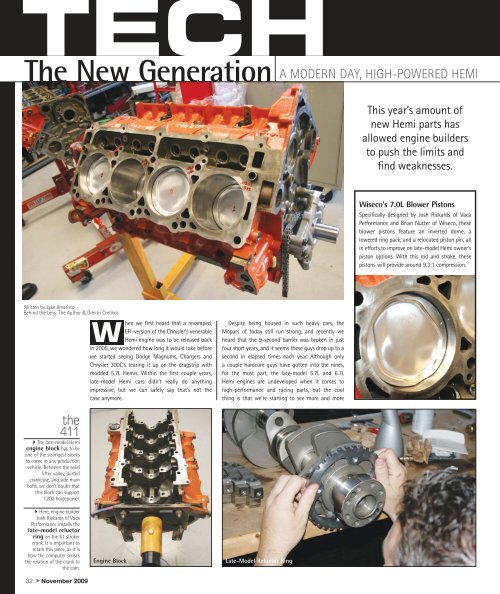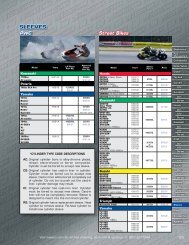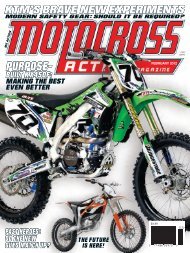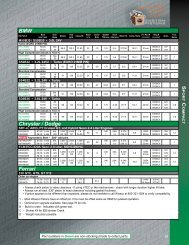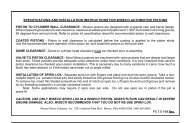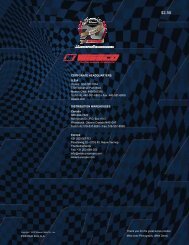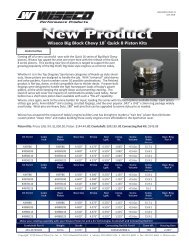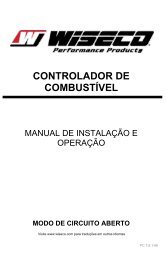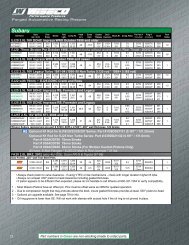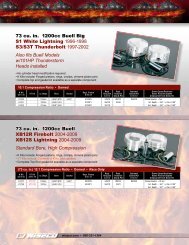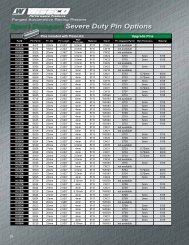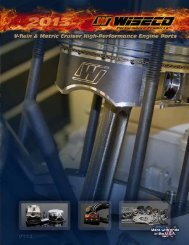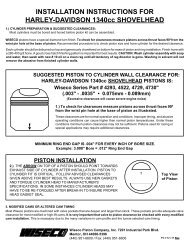Hemi Tech Spotlight - Wiseco
Hemi Tech Spotlight - Wiseco
Hemi Tech Spotlight - Wiseco
Create successful ePaper yourself
Turn your PDF publications into a flip-book with our unique Google optimized e-Paper software.
TECH<br />
The New Generation<br />
A MODERN DAY, HIGH-POWERED HEMI<br />
This year’s amount of<br />
new <strong>Hemi</strong> parts has<br />
allowed engine builders<br />
to push the limits and<br />
find weaknesses.<br />
<strong>Wiseco</strong>’s 7.0L Blower Pistons<br />
Specifically designed by Josh Rickards of Vaca<br />
Performance and Brian Nutter of <strong>Wiseco</strong>, these<br />
blower pistons feature an inverted dome, a<br />
lowered ring pack, and a relocated piston pin, all<br />
in efforts to improve on late-model <strong>Hemi</strong> owner’s<br />
piston options. With this rod and stroke, these<br />
pistons will provide around 9.3:1 compression.<br />
Written by Jake Amatisto<br />
Behind the Lens: The Author & Dimitri Cretikos<br />
W<br />
hen we first heard that a revamped,<br />
EFI-version of the Chrysler’s venerable<br />
<strong>Hemi</strong> engine was to be released back<br />
in 2005, we wondered how long it would take before<br />
we started seeing Dodge Magnums, Chargers and<br />
Chrysler 300C’s tearing it up on the dragstrip with<br />
modded 5.7L <strong>Hemi</strong>s. Within the first couple years,<br />
late-model <strong>Hemi</strong> cars didn’t really do anything<br />
impressive, but we can safely say that’s not the<br />
case anymore.<br />
Despite being housed in such heavy cars, the<br />
Mopars of today still run strong, and recently we<br />
heard that the 9-second barrier was broken in just<br />
four short years, and it seems these guys drop up to a<br />
second in elapsed times each year. Although only<br />
a couple hardcore guys have gotten into the nines,<br />
for the most part, the late-model 5.7L and 6.1L<br />
<strong>Hemi</strong> engines are undeveloped when it comes to<br />
high-performance and racing parts, but the cool<br />
thing is that we’re starting to see more and more<br />
the<br />
411<br />
4The late-model <strong>Hemi</strong><br />
engine block has to be<br />
one of the strongest blocks<br />
to come in any production<br />
vehicle. Between the solid<br />
lifter valley, skirted<br />
crankcase, and side main<br />
bolts, we don’t doubt that<br />
this block can support<br />
1,200 horsepower.<br />
4Here, engine builder<br />
Josh Rickards of Vaca<br />
Performance installs the<br />
late-model reluctor<br />
ring on the K1 stroker<br />
crank. It is important to<br />
retain this piece, as it is<br />
how the computer senses<br />
the relation of the crank to<br />
the cam.<br />
32 November 2009<br />
Engine Block<br />
Late-Model Reluctor Ring
TECH<br />
The New Generation<br />
A MODERN DAY, HIGH-POWERED HEMI<br />
Recently we heard that the<br />
9-second barrier was broken<br />
in just four short years.<br />
Ring Package<br />
The ring package was moved<br />
down .125-inch to accommodate<br />
the supercharger. Since these are<br />
specifically designed blower<br />
pistons, the ring lands will be less<br />
susceptible to lifting under high<br />
loads (below).<br />
The piston pin on these<br />
pistons is way up there, seemingly<br />
just a fraction of an inch<br />
from the bottom of the piston.<br />
But surprisingly, the pin boss<br />
only intrudes with the oil ring.<br />
Totally Square Engine<br />
It’s exciting to write about such a new engine<br />
combination, especially when it has parts in it that have<br />
not been released to the aftermarket yet. Rickards and<br />
<strong>Wiseco</strong>’s Brian Nutter came up with an inverted dome<br />
(not a reversed dish) design that provides a much more<br />
efficient flame front and provides more quench area than<br />
previous dished designs. Rickards explained, “The<br />
problems with the first generations of late-model <strong>Hemi</strong><br />
pistons was that they came with a reverse dish, not<br />
inverted dome. With the reverse dish you lose a lot of<br />
quench area of the cylinder head. With this new <strong>Wiseco</strong><br />
set, we’ve developed a piston that allows the flame front<br />
in the cylinder to be much more controllable.” Rickards<br />
continued, “The wrist pins have also been relocated closhardcore<br />
parts starting to be released, despite this downed economy. This year’s<br />
amount of new <strong>Hemi</strong> parts has allowed engine builders to push the limits and find<br />
weaknesses, and it seems everyday we’re learning about new components that<br />
will make the late-model <strong>Hemi</strong> run quicker and faster. With a steady stream of<br />
new, hardcore engine parts being released this year, these engines may start to be<br />
taken more seriously when it comes to performance and racing. It happened with<br />
Ford’s Modular engine, and now it’s become a major threat in some heads-up drag<br />
racing classes. The new <strong>Hemi</strong> aftermarket is a little far off to support purpose-built<br />
race motors, but it’s getting there.<br />
Last year we covered a Vortech supercharger install and dyno tune on fellow<br />
office park tenant Dimitri Cretikos’ blown 6.1L <strong>Hemi</strong> Charger. This year, Cretikos<br />
wanted to step up the power with a K1 Stroker kit, as well as some trick internals<br />
that have yet to be released, so Fastest Street Car was there to check it out. When<br />
it comes to late-model <strong>Hemi</strong> building skills and design, Josh Rickards of Vaca<br />
Performance is the man to talk to, and you could even say the 5.7L and 6.1L <strong>Hemi</strong>s<br />
are Rickard’s specialty. Rickard’s claims this new 426 engine will propel a full<br />
interior Charger into the 10-second range.<br />
Piston Squirters<br />
the<br />
411<br />
4The K1 <strong>Tech</strong>nologies<br />
crank features a 4.080-inch<br />
stroke while the block is<br />
also bored to 4.080, a<br />
totally square<br />
engine. This provides the<br />
Mopar-essential 426 cubicinch<br />
number.<br />
4The first generation of<br />
late model <strong>Hemi</strong> stroker<br />
kits required the builder to<br />
remove the piston<br />
squirters. With <strong>Wiseco</strong>’s<br />
new 6.1L blower pistons,<br />
you can still retain them.<br />
nmcadigital.com<br />
35
TECHA MODERN DAY, HIGH-POWERED HEMI<br />
The New Generation<br />
“I still have a few tricks<br />
up my sleeve.”<br />
—Josh Rickards<br />
Vaca Performance<br />
the<br />
411<br />
4The connecting<br />
rods we used on this<br />
build came from K1<br />
<strong>Tech</strong>nologies. They are<br />
forged from 4340 steel and<br />
feature an H-beam design<br />
that will be up to the task<br />
of holding on to our<br />
supercharged slugs, even<br />
when pushing a<br />
4,000-pound land yacht<br />
down the track.<br />
4The ring package is a<br />
secret setup that Josh<br />
Rickards claims will be a<br />
real help in making big<br />
power with this engine.<br />
With a low-tension oil ring,<br />
this engine can turn over<br />
with only about 9 pounds<br />
of force. Compare that to<br />
the 25-30 pounds a<br />
big-block Chrysler has, and<br />
you are talking about a lot<br />
of freed-up power.<br />
er to the crown, and the ring package has been<br />
moved down .125. The skirts are coated and they<br />
come with priority pin oiling, plus they’ve been<br />
notched for the factory oilers.” The piston oilers<br />
basically cool the underside of the pistons by<br />
squirting a bit of oil though a series of dual-nozzle<br />
gadgets that get bolted into the crankcase. The<br />
ability to use the piston oilers with these pistons is a<br />
big deal because, before, anytime you ran a 426<br />
stroker crank, you couldn’t run the oilers because the<br />
stroke. These, however, have notches that permit you<br />
to use them. It’s nice to know that under high-boost<br />
some cool oil is getting directed to one of the hottest,<br />
most intense parts of your engine.<br />
The K1 <strong>Tech</strong>nologies crank we opted to use is a<br />
forged 4340 steel piece with a 4.080 stroke to give<br />
our <strong>Hemi</strong> a classic 426 cubic-inches. K1 <strong>Tech</strong>nologies<br />
is a company with attention to detail and have<br />
regarded themselves as one of the most meticulous<br />
when it comes to checking tolerances. The<br />
counterweight placements on this crank are designed<br />
for improved performance and the journals feature a<br />
.125-inch fillet radii. Other features include a<br />
straight-hole oiling system for better lubrication and<br />
the crank has been Nitrided for improved bearing life.<br />
Of course, the crank also has the provisions for the<br />
factory reluctor ring, too.<br />
Connecting Rods<br />
Milodon’s Late-Model <strong>Hemi</strong> Stuff<br />
We originally contacted Milodon for the oil pan, pickup, and windage tray for this engine build.<br />
Unfortunately, we ordered the wrong pan for the body style we plan on dropping this beast into. Milodon<br />
does offer a pan that would work with our 6.1L stroker, we just couldn’t get one in time. We could,<br />
however, make the windage tray work with the factory pan with some slight massaging. For more info on<br />
their <strong>Hemi</strong> pans, check out milodon.com.<br />
The K1 rods are forged, 4340 steel H-beams that have been shot peened for<br />
improved fatigue life, come with bronze wrist pin bushings, and are finish honed<br />
in the USA. They are also weight-matched +/- 1 gram on each end and also come<br />
with the ultra-strong ARP 2000 fasteners.<br />
For the oiling system, Rickards retained the factory oil pump, but opted to go<br />
with a Milodon windage tray and pan kit. Unfortunately, we ordered the wrong pan<br />
and had to temporarily use the factory one, but we do want to mention that<br />
Secret Setup<br />
36 November 2009
TECH<br />
The New Generation<br />
A MODERN DAY, HIGH-POWERED HEMI<br />
“I set this engine up to be<br />
totally streetable<br />
on pump gas.”<br />
Milodon does have a whole line of aftermarket pans<br />
and trays for the late-model 5.7 and 6.1L <strong>Hemi</strong><br />
engines. The windage tray is an improved design over<br />
factory steel gasket/windage tray, as it does a better<br />
job of shielding the crank from the splashing oil.<br />
Windage control is something that is rarely tested<br />
with the late-model <strong>Hemi</strong> engines, so Rickards was<br />
curious to see if it was worth any power.<br />
With a few late-model crazies already running in<br />
the 9-second zone, we asked Rickards if he thought<br />
this powerplant could ever propel our Charger project<br />
into the 9s. He said, “I set this engine up to be<br />
totally streetable on pump gas, daily driven even.<br />
Now, if Dimitri wants to go even quicker than this<br />
after it’s done, I still have a few tricks up my sleeve…”<br />
With it having 426 cubic-inches and heads that flow<br />
330 cfm, we don’t think power will be a problem, but<br />
Rickard’s ended the call with,“…but we’re going to<br />
need a bigger blower.” g<br />
the<br />
411<br />
4ATI sent us their Super<br />
Damper for this<br />
high-powered <strong>Hemi</strong> build.<br />
Some basic features<br />
include 360° laser-etched<br />
timing marks and they<br />
exceed SFI 18.1 specs. We<br />
ordered this one with<br />
5-percent overdrive, this<br />
way we can run the<br />
desired 12-pounds of boost<br />
without having to go<br />
too small on the<br />
supercharger pulley.<br />
4ARP supplied the<br />
fasteners for the<br />
buildup, including the full<br />
set of main studs for our<br />
Mopar’s beefy crankcase.<br />
Super Damper<br />
Fasteners<br />
Time To Drop It In<br />
Now that our K1 <strong>Tech</strong>nologies Stroker Kit is bolted in place, it’s time to drop the shortblock in the car (the<br />
top ends of these engines are assembled with the engine in the car ~editor) and assemble the top end. In<br />
the next installment of our “New Gen” <strong>Hemi</strong>, we’ll cover the heads and induction setup we’re using on this<br />
project, along with some real word dyno numbers from Vaca Performance’s Dyno.<br />
S O U R C E<br />
Vaca Performance<br />
562.622.2508<br />
vacaperformance.com<br />
K1 <strong>Tech</strong>nologies<br />
616.583.9700<br />
k1technologies.com<br />
ATI Performance Products<br />
877.298.5039<br />
atiracing.com<br />
<strong>Wiseco</strong> Pistons<br />
800.321.1364<br />
wiseco.com<br />
Automotive Racing Products<br />
800.826.3045<br />
arp-bolts.com<br />
Milodon Inc.<br />
805.577.5950<br />
milodon.com<br />
Automotive Racing Products<br />
800.826.3045<br />
arp-bolts.com<br />
38 November 2009


